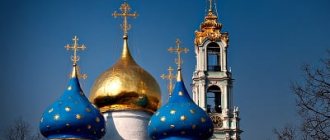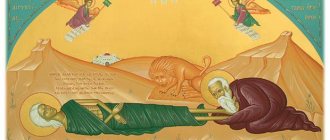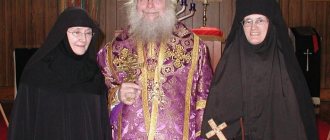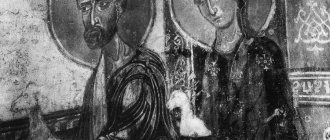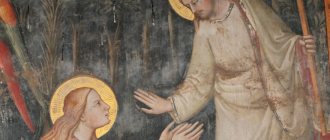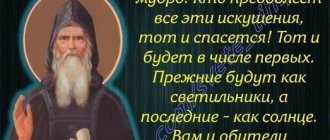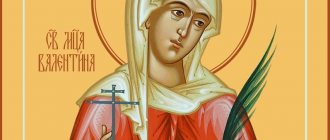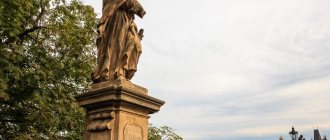St. Lazarus of four days and his sisters Martha and Mary
Excerpt from “The Life and Works of the Holy Glorious and All-Praised Twelve Apostles of the Lord, the Seventy Lesser Apostles and Other Equal-to-the-Apostles Evangelists of Christ”
Our Lord Jesus Christ, during His earthly life, did not spend time more calmly and happily anywhere than in Bethany, in the family of Martha and Mary and their brother Lazarus, as can be seen from the instructions of the Evangelist John the Theologian, who says: Jesus loved Martha and her sister and Lazarus (John 11:5). From the legends of St. Evangelists here is what we know about this pious family. Thus, the Evangelist Luke narrates that once the Lord was in Bethany and here a woman named Martha invited Him to her house. Martha’s sister, Mary, sat at the feet of Jesus and listened to His teachings. Meanwhile, Martha was trying to please the Lord better and, approaching Him, said: Lord, or don’t you need it, that my sister left me alone to serve! tell her to help me. Jesus answered and said to her: Martha! Marfa! you care and fuss about many things, but only one thing is needed; Mary chose the good part, which will not be taken away from her (Luke 10:38-40). In addition, the three Evangelists mention sister Mary in their Gospels, almost identically conveying the story of the anointing of Jesus Christ with precious myrrh at a supper in the house of Simon the leper, which was performed by Mary, the sister of the resurrected Lazarus. The Evangelists' story is stated as follows: Six days before Easter, on the eve of Christ's entry into Jerusalem for the free passion, when Christ was in Bethany at the supper prepared for Him, in the house of Simon the leper, and Lazarus, resurrected by Christ, shared a meal with Him, and Martha served Him, Mary Taking a vessel with precious ointment, she anointed Jesus’ feet with it, wiped them with her hair and poured ointment on His head. At the same time, Judas Iscariot expressed his opinion that it would be better to sell this ointment and give the proceeds to the poor; The Lord Jesus Christ objected to this: “Why are you embarrassing this woman? She did a good deed for Me, because you always have the poor with you and can do good to them whenever you want, but you don’t always have Me. She did what she could, pouring this myrrh onto My body, she prepared Me for burial. And behold, I tell you truly, that wherever the Gospel is preached, in the whole world, what she has done will be told” (Matthew 26:6–13; Mark 14:3–9; John 12:1– 8).
The faith of these sisters in Jesus Christ was so ardent and sincere that when their brother Lazarus fell ill, the first thing they did was notify Jesus Christ of his illness, trusting only in Him alone that He could give relief to their brother. When Jesus came to Bethany, it had already been four days since Lazarus lay in the tomb. Bethany lay not far from Jerusalem and many of the inhabitants of Jerusalem came to Martha and Mary to console them in their grief. When Martha heard that the Lord was already close to their village, she went to meet Him and said: “Lord! If You had been here, my brother would not have died!” “Your brother will rise again,” Jesus Christ told her. Martha answered: “I know that he will rise on the Resurrection, on the last day.” Jesus said to her: “I am the Resurrection and the Life; whoever believes in Me, if he dies, he will live. And everyone who lives and believes in Me will never die. Do you believe this? “So, Lord, I believe that You are the Christ, the Son of God, who came into the world,” said Martha and, leaving Jesus, went home, secretly called her sister and said: “The Teacher is here and is calling you.” Mary immediately went to meet the Lord, fell in tears at His feet and cried out: “Lord! If You had been here, my brother would not have died!” The Jews, who left the house with Mary to follow her, as they thought, to her brother's grave, began to weep as they looked at her. Then the Lord was grieved and disturbed in spirit. He asked, “Where did you put it?” They answer him: “Lord! Come and see." Seeing tears in Jesus' eyes, the Jews said: “Look how He loved Lazarus! Couldn’t He, who opened the eyes of the blind man, prevent this one from dying?” Meanwhile, Jesus, grieving internally, approaches the cave in which the dead man lay. The cave was filled with stones; Jesus commanded that it be taken away. Then Martha said: “Lord! He’s been in the coffin for four days now, and there’s a bad smell.” Jesus said to her: “If you believe, you will see the glory of God.” When the stone was taken away, Jesus looked up to heaven, saying: “Father! I thank You that You heard Me, I knew that You would always hear Me, but I said this for the people standing here, so that they would believe that You sent Me.” Having said this, He cried out in a loud voice: “Lazarus! Get out!” The deceased immediately left. He was wrapped in burial cloths, and his face was covered with a scarf. “Unbind him, let him go,” said the Lord (John 11:1-3, 17-44). In addition, the Evangelist mentions that the resurrected Lazarus was with Jesus Christ at a supper in the house of Simon the leper (John 12:1).
After the murder of St. Archdeacon Stephen, when the persecution of Jerusalem Christians began, St. Lazarus was expelled from Judea and put out to sea in a boat without oars. By God's Will, the boat sailed to Fr. Cyprus, where in the city of Kydonia St. Lazarus began to preach Christ as an apostle, and was a bishop in this city, ordained to this rank by the Apostle Barnabas. Living in Cyprus, St. Lazarus ardently desired to see the Most Holy Theotokos, whom he had not seen for a long time, and he himself was afraid to arrive in Jerusalem to meet with Her. The Most Holy Theotokos, realizing this desire of St. Lazarus, wrote a message to him, in which, consoling him, she commanded him to send a ship for Her, on which She could arrive on the island of Cyprus, and forbade him to come to Jerusalem for Her sake. After reading this message, St. Lazarus was very happy, and also surprised at such humility of the Most Holy Theotokos, and without any delay, he equipped and sent a ship for Her. The Most Holy Theotokos, together with the Apostle and Evangelist John and some other companions, set sail on this ship to the island of Cyprus. On the way, due to contrary winds, the Mother of God had to land at Mount Athos. After a short stay here, the Most Holy Theotokos arrived on Fr. Cyprus, where I met St. Lazarus, who grieved over Her long journey, told Him about Her stay on Mount Athos and presented gifts specially made for him with her own hands - an omophorion and armlets. After spending a short time in Cyprus, the Mother of God returned to Jerusalem.
After the stay of the Most Holy Theotokos, St. Lazarus spent four days as a bishop in Cyprus for about thirty years, preaching Christ and confirming the faith of the pagans he converted, in which his sisters Mary and Martha zealously helped him. Where, when and how did the saints end their lives? Lazarus's sister is unknown from church traditions, but St. four-day-old Lazarus rested in peace on Fr. Cyprus.
Under Emperor Leo the Philosopher (886–911), the relics of St. Lazarus of four days was transferred from Cyprus to Constantinople. Historians Kedrin and Zonara talk about this event.
Memory of St. Lazarus of the Four Days is celebrated by the Holy Church on October 17, when the transfer of his relics from Fr. Cyprus to Constantinople, and the memory of his sisters Martha and Mary is celebrated on the Week of the Myrrh-Bearing Women.
Orthodox Life
Nowadays, we often hear that most of the saints, whose memory was included in the general Church Monthly Dictionary, are representatives of the monastic rank, while pious laymen who lived family life mostly remained in the fields of the Saints.
It is perhaps difficult to disagree with this statement. For the modern layman, the same question remains relevant: “How to be saved in the world”? That is why the lives of the lay saints do not lose their significance even today. These include the Life of St. Mary the New († c. 907), unknown to a wide range of readers, written in the 10th–11th centuries. This valuable monument of Byzantine hagiography was first discovered on Mount Athos (in the library of the Great Lavra) by the famous Greek researcher Manuel Gideon (1851–1943), after which the Life became the subject of study by specialists. Gideon brought the memory of the son of St. Mary, Venerable Vahan-Marin, in the Byzantine Monthly Book he compiled, and the memory of the saint herself on the 16th day of the month of February was included in his “New Synaxarion of the Orthodox Church” by the modern hagiologist Fr. Macarius of Simonopetra.
As the Life tells, Mary was born in the second half of the 9th century. in an Armenian aristocratic family, believed to have descended from the Mamikonyan family. Together with some other representatives of the Armenian nobility, the saint’s parents moved to Constantinople, where they were received with honors by Emperor Basil I (876–886). Vasilevs Romeev rewarded the guests with gifts and government positions. So the family of the future saint settled in Constantinople, and Maria was married to a soldier Nicephorus from the village of Mesina, in Thrace (Eastern Balkans). A short time passed, and rumors about the unusually kind young lady spread around the region. Compassionate and sympathetic, Maria did not refuse help to anyone who turned to her. Mary's active mercy caused people's amazement. So, one day, when a tax collector arrived in Mesina, he began to arrest those who could not pay taxes. Maria, having heard about this, hastened to take loans from her friends and paid taxes instead of her poor fellow villagers. The poor people rescued from prison, instead of going to their homes, first of all hurried to Mary, thanking her for their salvation. And this was not an isolated case when Mary’s love for her neighbors was manifested. Every day, morning and evening, she went to a village temple, which was not close to her house; she had to cross a river without a bridge. Only a serious illness could tear Mary away from visiting the temple.
However, the life of the young couple was not cloudless. The first blow of fate befell Mary and Nikephoros when their five-year-old firstborn Orestes died. A few years later, the second baby named Vardan also died. Of course, it was extremely difficult for Mary to survive the pain of losing two babies, but she overcame the grief and did not lose her faith and love for God.
In the meantime, the family from the village moved to the city of Vizia, because Nikifor, having distinguished himself in the war against the Bulgarians, received a promotion. The change of situation did not affect Maria's life. She continued to be a support for widows and orphans, a nourisher for wanderers, beggars and desert monks. Maria also treated her servants with special care and did not punish any of them, knowing that their situation was already difficult. The only change was that the righteous woman now did not go to the temple every day, not wanting to attract the curious glances of the townspeople, but prayed at home. When Nicephorus was at home, Mary fasted only during Great Lent, and at other times she completely gave up meat.
Soon Maria gave birth to twins, the elder of whom was named Vaan, and the younger - Stefan. The mother predicted that one of the newborns would become a military man, and the second a monk, but she herself would not see this. Life seemed to flow on as usual, but the last and most difficult test awaited Maria, which could have nullified all her exploits. The blow came from an unexpected direction: Nikifor’s brother and sister – Alexy and Elena – began to slander the righteous woman, allegedly she was wasting her husband’s estate and cheating on him with one of the servants. Nikifor believed the slander. He did not really heed Mary’s assurances about her fidelity and since then changed his attitude towards his wife. She was under surveillance and her expenses were controlled. Believing another slander, Nikifor beat Maria on the first day of Lent, who also, probably due to emotional distress, had increased stomach pain. Wanting to escape from the enraged Nicephorus, Maria hastened to take refuge in one of the rooms, but fell and broke her head. After lying in serious condition for ten days, she asked Nikephoros to come to her. For the last time, Maria asked her husband to believe in her innocence and told him, already sobbing, about her imminent departure. In the last minutes of her life, Mary saw the heavens open, an indescribable light and a descending crown.
While the body of the deceased was being prepared for bathing, a sweet fragrance spread from it. When they began to look for a dress to put on over her undershirt, it turned out that the deceased had donated all her clothes and jewelry to the needs of the poor. Nikephoros' tunic had to be urgently altered to resemble a woman's dress, in which the saint's body was dressed. When almost the entire city gathered, Bishop Euthymius of Visium buried Mary’s body in the cathedral.
Four months later, an unknown demoniac named Stratigius arrived in Visia, who began to insist that he should receive healing from the tomb of Mary. Bishop Euthymius reacted extremely negatively to such words, declaring that the grace of miracles was given to monks and martyrs, but not to family people! The indignant Nicephorus wanted to imprison the possessed man, thinking that he was pretending to be possessed at the instigation of Mary’s relatives. One Sunday, in the presence of the bishop, Nicephorus and the people, Stratigius demanded that the saint’s sarcophagus be opened. To the amazement of those present, Mary’s body turned out to be incorrupt. The possessed man kissed the holy right hand, immediately vomited blood - and Stratigius received healing. One of the clergy, noticing the blood on the saint’s face and believing that it was the blood of Stratigius, tried to cleanse it, but it turned out that living blood was flowing from the saint’s nose!
After this miracle, many sick people began to flock to Visia, especially the blind, the mentally ill and the possessed, who received healing from the relics of the saint. For decades, her body remained intact and undamaged from decay. As Mary predicted, the younger of her twins, Stefan, became a monk with the name Simeon, and the elder, Vaan, became an outstanding military man, but at the end of his life he took monastic vows from his brother with the name Marin.
From the Life it becomes clear that back in the 10th century. the idea that the monastic feat is higher than the feat of a Christian in the world was widespread in church circles, and therefore the glorification of Mary with the incorruption of her relics and the gift of miracles caused indignation among some “zealots of piety.” The author of the Life especially notes that the rumor about the miracles of St. Righteous Mary began to be refuted by certain monks who, driven more by envy than by jealousy, argued that not even all monks, deprived of all pleasures, spending day and night in prayer and fasting, are awarded the gift of miracles, therefore, it is impossible for a person who has eaten meat , having experienced the joys of married life, became a miracle worker. The answer of the author of the Life is extremely simple: the secret of the holiness of Mary the New lies in the fact that she fulfilled the vows of holy Baptism in purity and to the end, which for the laity is in itself a measure of perfection! This alone, that is, the faithful fulfillment of the vows of Baptism, a Christian deserves from God the gift of miracles! In addition, Mary was distinguished by her mercy, this fruit of love, which God rejoices so much that He Himself wants to be called Love! Another important idea (expressed by an unknown Byzantine hagiologist) is that no objective or subjective circumstances, in this case the weakness of female nature, marital responsibilities, concerns about raising children and family troubles, not only cannot prevent a person from his desire to God, but on the contrary, if a person has a good disposition, then everything contributes to his spiritual growth. For, as the holy Apostle Paul said, “all things work together for good to those who love God” (Rom. 8:28).
Gevorg Kazaryan Image of St. Maria Nova – Gevorg Kazaryan
Troparion to the righteous Martha and Mary of Bithynia, tone 3
The God-loving sisters of Righteous Lazarus, / Martha and the most glorious Mary, / with the pure heart of Christ in your life, loved nature, / the myrrh-bearers of the rank, / and Him, I to the Son of God, fearlessly confessed to nature, / for this reason now in the abodes of the Heavenly Father / with Angels and You reign gloriously with all the saints./ Pray, He who was loved by nature,/ and we, sinners, may be established in the faith and love of Christ// and be granted the Kingdom of Heaven.
Translation: God-loving sisters of Righteous Lazarus, glorious Martha and Mary, with a pure heart you loved Christ in your life, having accepted the rank of myrrh-bearers and Him as the Son of God, you confessed without fear, therefore now in the abodes of the Heavenly Father you reign with glory with the Angels and saints . Pray to Whom you have loved, and for us sinners to be confirmed in faith and love for Christ and to be worthy of the Kingdom of Heaven.
Prayer to the righteous Martha and Mary of Bithynia
Oh, holy and all-praised disciples of Christ, God-loving Martha and Mary! Pray to the Sweetest Jesus, whom you have loved and who has loved you, Whom you have confessed by nature, Christ, the Son of God, that He may also grant us, sinners, remission of sins, in the right and unfeigned faith of yours. standing erect. Instill in our hearts the spirit of the fear of God, humble trust in God, patience and mercy towards our neighbors. Deliver us with your prayers from the temptations of life, troubles and misfortunes, yes, having lived here in a quiet and peaceful life, with immaculate thoughts and a pure heart, with the boldness of faith and hope, we will come to this Last Judgment and, having given a good answer to it, eternal joy in the Kingdom Let us be worthy of heaven. Amen.
JOHN AND MARY
(2nd half of the 13th century), righteous (memorial on the 3rd Sunday after Pentecost - in the Cathedral of Vologda Saints), Ustyug. Information about I. and M. was preserved in the Ustyug Chronicle, compiled in the beginning. XVI century (PSRL. T. 37. P. 30, 70). There is a message going back to the Laurentian Chronicle about uprisings against the Mongols in 1262 in Rostov, Vladimir, Suzdal, Pereyaslavl (Pereslavl-Zalessky), Yaroslavl and the Ustyug legend about the baptism of the Mongol in Ustyug. the tax collector of the “hero” Baguya (Bug) (the text of the legend is almost identical in different editions of the chronicle). “Yasashchik” Bagui was cruel to the residents of Ustyug. So, for non-payment of yasak, he forcibly took a certain girl as a concubine (the girl’s name is not mentioned in the early version of the legend). When in Russian An uprising against the Mongol broke out in cities. The governors and Ustyug residents decided to kill Baguya (in the Ustyug chronicle this decision is explained by the receipt in the city of a letter from Prince St. Alexander Yaroslavich Nevsky about “beating the Tatars”), the girl warned Baguya. He, “came to the meeting, and with his brow pressed on their will to be baptized and to marry the girl.” Bagui received the name John in baptism. Once, while falconry, I., tired, fell asleep under a tree on Falcon Mountain. In a dream vision St. appeared to him. John the Baptist ordered the foundation of a church dedicated to him on this site. I. fulfilled the command by building a temple in honor of the Nativity of St. John the Baptist. The Ustyug Chronicler (contains news of local history, created no earlier than the end of the 17th century) reports that later. A monastery was founded here in the name of St. John the Baptist (“The place of that mountain is a ridge and to this day it is called Sokolya Mountain from the Predotechevsky Monastery” (Ibid. pp. 104-105, 110)). In the Ustyug Chronicler and in the “Chronicle of the Great City of Ustyug” Priest. Ustyug Assumption Cathedral of Lev Vologdin 1765-1767. The name of the girl with whom Bagui was married is named - Maria. In the "Chronicle" St. Lev Vologdin also indicates the date of Baguya’s baptism - 1267 (Ibid. pp. 129-130).
Certain details of the text of the legend allow us to see in it a local record of the 13th century. According to A.N. Nasonov, the premise of the book. Alexander Nevsky's letter to Ustyug on resistance to the Mongols is quite possible, since in the beginning. 60s XIII century tribute collectors came to Rus' not from the Khan of the Golden Horde, Berke, but from the emperor. Kublai Khan's Mongol Empire. Following This is the expulsion of the Mongols from Russia in 1262. cities should not have caused and did not cause punitive measures on the part of the Golden Horde, and, thus, the book. Alexander Yaroslavich could have been one of the initiators of the uprising (see: Nasonov A.N. “Russian Land” and the formation of the territory of the Old Russian State: Historical-geographical research. Mongols and Rus': History of Tatar politics in Rus'. St. Petersburg. , 2002. pp. 254-258). Another evidence in favor of the antiquity of the story about I. and M. in the Ustyug chronicle is the mention of the veche, to which Bagui addressed, since in the 14th century. messages about veche meetings in the cities of the North-East. Russians cease to appear in sources.
In the legend about I. and M., motifs from folk legends about heroes are noticeable. Probably, the story about I. and M. originally existed as an oral tradition and, thanks to this, certain folklore features were preserved in it. This legend was included in the Ustyug chronicle along with the legend about the Monk Cyprian († 1276) - the founder of the Ustyug monastery in the name of the Archangel Michael. In later versions of Church Tradition, the contemporaries and interlocutors of I. and M. named the Ustyug saints St. Cyprian and blessed Procopius († 1303), but this is not confirmed by sources.
I. and M. were revered in Ustyug as righteous spouses. In a number of lists of “Descriptions of Russian Saints” (the work is known in manuscripts of the 18th-19th centuries), M. is called sister I. From the 16th century. The tomb of saints is known near the Ustyug Ascension Church. at the Old Market, mentioned in the Praise of the Blessed. John of Ustyug: “And the ancient miracle workers of that city of Ustyug: about the righteous women of John and Mary, laid down at the Ascension of Christ...” (RGB. Music No. 1365. L. 195, 16th century). When the stone Ascension Church was built in 1648. on the site of a burnt wooden church, the burial of the saints was in the chapel in honor of the Exaltation of the Cross of the Lord near the north. walls, under the window. According to the scribe book of 1676-1683, the tomb of I. and M. in the Ascension Church. was decorated with veils and images of saints; The temple also contained “an image of the righteous saints John and Mary, painted on gold sheets.” As a result of repeated reconstructions of the temple, the tomb was lost; in memory of it, on the outside of the wall, in a niche under the window, there was an image of the saints. The canonization of I. and M. is confirmed by the inclusion of their names in the Council of Vologda Saints, the celebration of which was established in 1841.
Source: PSRL. T. 37; Description about Russian saints. P. 148.
Lit.: Popov A. Description of St. John the Baptist Monastery // Vologda EV. 1865. P. 15; Barsukov. Sources of hagiography. Stb. 258; Veryuzhsky. Vologda saints. pp. 47-52; Sergius (Spassky). Monthsword. T. 3. P. 561; Golubinsky. Canonization of saints. P. 142; Vlasov A. N. Ustyug literature of the 16th-17th centuries: Ist.-lit. aspect. Syktyvkar, 1995. pp. 34-38.
A. N. Vlasov
Iconography
The originals describe the appearance of I. and M. on May 15 or 25: “John is gray-haired, bearded the Theologian, not bald, the robe of Joachim is simple” (IRLI (PD). Perez. No. 524. L. 165; see. also: RNB. SPbDA. A.II.546. L. 28 vol.), to the same text can be added: “...cinnabar, cabbage roll underneath. And in some cases, like Joachim the God-Father, sitting over a brad, in a shirt, and Mary like Julita” (BAN. Strict. No. 66. L. 110). About M. it is said: “... a robe of fine green, a cormorant underneath, a cross in his right hand, another prayer service” (RNB. Weather. No. 1931. L. 161).
In 1683 in the center. Ascension of the Lord in Vel. In Ustyug there were 2 icons of I. and M.: one “on the tomb of the saints, the righteous John and Mary, painted on paint”, the other was made on gold sheets, “the image of the Savior is written in the cloud, and on the Savior’s image and on John and Mary there are crowns silver, basmy, gilded" (Veryuzhsky. Vologda Saints. P. 51-52).
Lit.: Markelov. Saints Dr. Rus'. T. 2. P. 128.
E.P.I.
